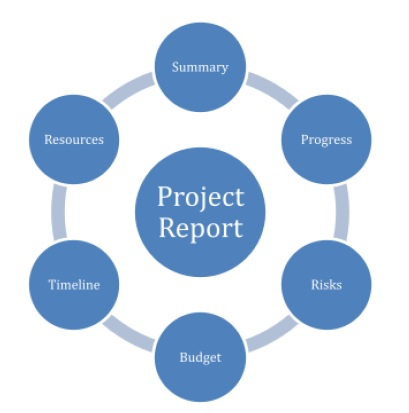
 Data Structure
Data Structure Networking
Networking RDBMS
RDBMS Operating System
Operating System Java
Java MS Excel
MS Excel iOS
iOS HTML
HTML CSS
CSS Android
Android Python
Python C Programming
C Programming C++
C++ C#
C# MongoDB
MongoDB MySQL
MySQL Javascript
Javascript PHP
PHPPhysics
Chemistry
Biology
Mathematics
English
Economics
Psychology
Social Studies
Fashion Studies
Legal Studies
- Selected Reading
- UPSC IAS Exams Notes
- Developer's Best Practices
- Questions and Answers
- Effective Resume Writing
- HR Interview Questions
- Computer Glossary
- Who is Who
How to Create a Project Report: Objectives, Components, Use Cases, and Examples

Only a project manager knows the struggle of keeping the stakeholders, end-users, and business associates up-to-date about the project's current status. Besides, following each requirement and instruction closely can get on your nerves. That’s where the project reports step in. A project report is an effective tool for managing all aspects of a project precisely. These reports help guide people in the right direction and show the accurate status of the project. If you don’t create a report, there’s no way you can know whether you achieved your customers’ expectations or the stakeholders’ goals.
What is a Project Report?
The main purpose of a project report is to keep track of the project status. These reports show you how far until the project is finished if your project is aligned with the manager’s instructions, and whether you are keeping the stakeholders informed about the progress. Depending on the project's complexity, you might need additional, detailed reports to get clear insights into your performance.
In addition to helping you with your current project, a report is an effective tool for future projects. You can document the risks or obstacles faced while working on the project, the methods you implemented to overcome those challenges, and how the results turned out. All this data comes in handy when you work on another similar project in the future. Let’s take a look at the five effective ways to create an easy-to-understand and detailed project report.
Five Steps for Creating a Project Report
Identify Your Goals
First thing first, you need to have a goal in mind. What do you want to achieve with your project report? Having clear goals will help your readers understand your perspective and the project you are working on. It’s also easier for your team to stay engaged and understand the requirements clearly when everything is documented.
Know Your Audience
Whatever you use in the report should satisfy your audience. After all, they are going to review the report. For example, a financial statement is entirely different from an employee’s performance report. It’s for different audiences and has totally different components. Your graphs, tables, charts, infographics, and comparison statistics must be aligned with your audience's needs.
Data Collection
A strong report is always backed by data. It instills trust in your audience. They are highly likely to believe what your report says when you use interviews, citations, statistics, and relevant sources to support your claims. Surveys also help, and so do all methods that prove you have accurate information.
Structure of the Report
A report is divided into several sections. The first is a summary. It gives your audience an overview of what your project is about, how it can help the readers, and what they will learn by the end of the report. Usually, a summary is written first (followed by the body and other sections), but in this case, you can only write a summary once you have finished the report. Then, there’s the introduction, body, and conclusion.
Edit and Proofread
Once you are done with the report, the next step is to edit and proofread it to ensure it has no logical, grammatical, or semantic errors. You can ask a professional editor to proofread the report for you or your manager to go over the details.
Objectives of a Project Report
A project report is based on a specific goal. Decide what you want to address in the report. Is it the time delays or employees’ performances? Or, are you going to discuss the development risks or challenges faced during the development and marketing? Or, is your report about convincing the investors to invest more funds into your upcoming project? A report can be simply about requesting permission from the management to start a new project or managing a budget.
Components
A well-written report is always divided into sections so that it’s easier for the reader to understand each part of the report clearly point out the errors. Although the components of a report vary greatly by the type of report or its purpose, a few common things included in each report are as follows.

Summary − as mentioned earlier, this section summarizes all information in the project in a small paragraph, giving readers insight into the report.
Progress − The report provides you with the metrics that show the project’s progress. The report identifies the challenges that have emerged while creating the report.
Risks − Every project is bound to face some challenges at some point. It’s important to identify those risks ahead of time and come up with smart solutions that could help mitigate them. In the report, you must conduct a detailed risk analysis and show the solutions that could help. The report also shows how these risks affect the report.
Budget − How much capital you need for the project, whether you need investors to raise more funds, and how you plan on allocating the budget to various steps in the project are a few important things to include in your report.
Timeline − A timeline shows whether your project is on track and how fast you have finished the tasks. Is your project behind, ahead, or on schedule? These details can be found in the timeline section.
Resources − The next element is the resources — all that you have used to craft the report. This must cover the machinery, equipment, and all types of tools used for completing the project. It should also provide a summary of how you’ve allocated the resources.
Conclusion
A project report is a crucial element of any project — whether it’s a financial report or a performance analysis. Having a project report won’t only give you a better understanding of your resource allocation and the timeline you have set for the completion, but it’s an effective way to request your supervisors and stakeholders to put more funds into your business. It also keeps the end users and stakeholders informed about the current status of your project and the progress you have made.

